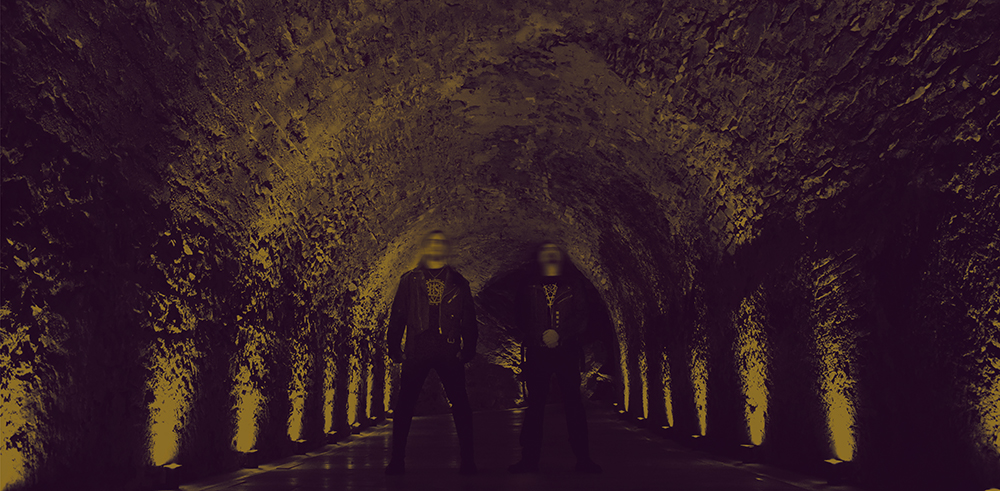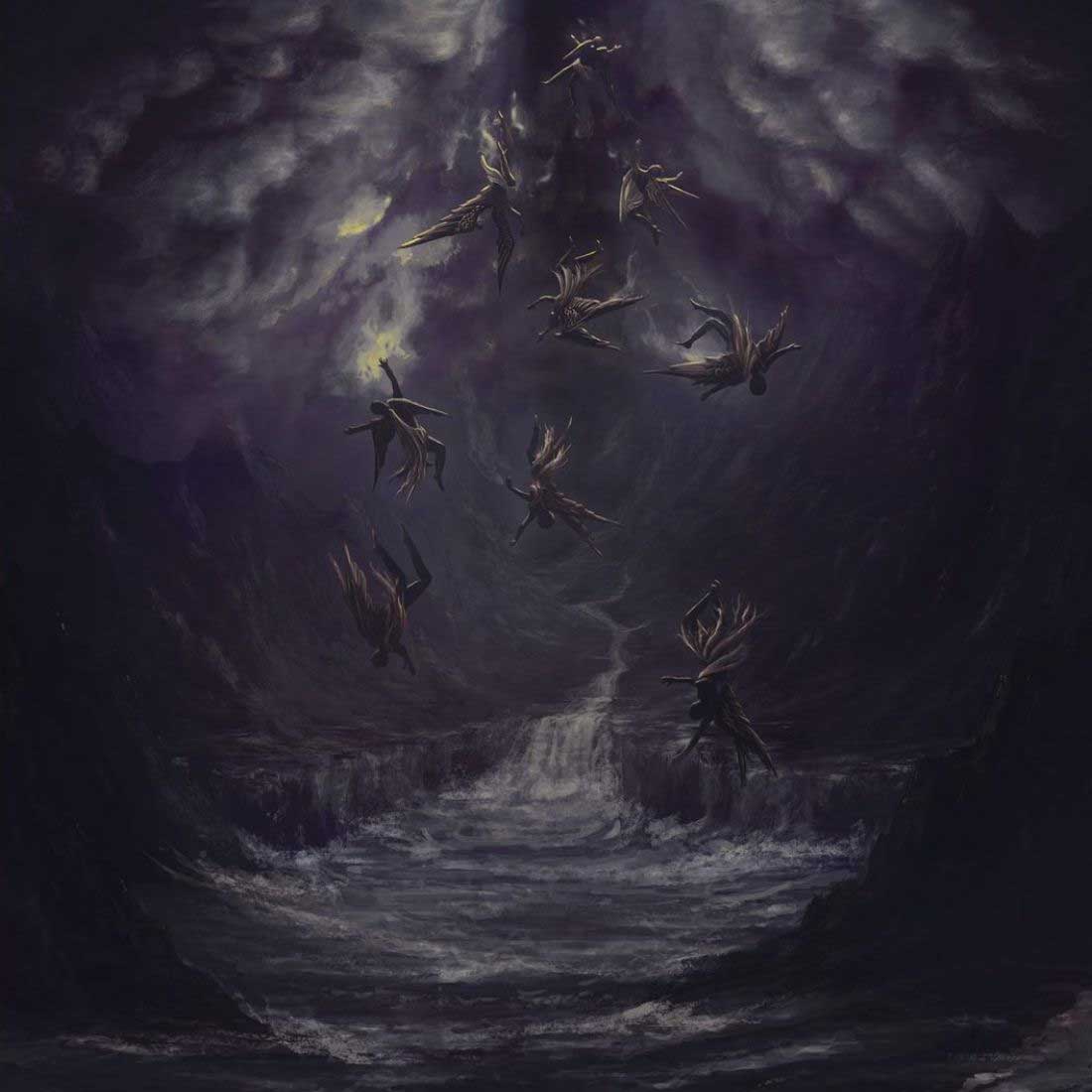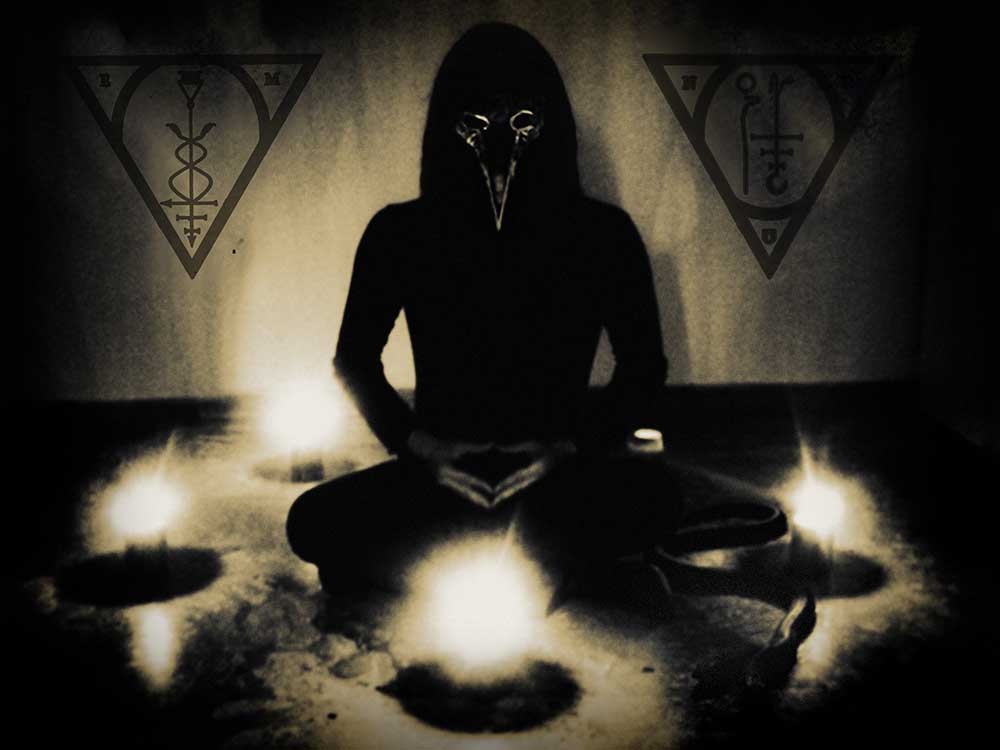Thy Darkened Shade
2023-01-10
by Niklas Göransson
Semjaza of Greek black metal band Thy Darkened Shade speaks of the magical and musical foundations of Liber Lvcifer II: Mahapralaya. Includes a full album stream.
– “Mahapralaya” is the third THY DARKENED SHADE album – part two of “Liber Lvcifer”, a theistic trilogy sprung from our reverence for and dedication to Lucifer. Composition-wise, I gathered a lot of hymnic, epic, and almost doomy ideas and paired them with some unusually technical approaches. This record brought out even more non-metal influences, all of which became fully embedded within the TDS framework; I wanted to create a unique synthesis of opposites.
“Liber Lvcifer II: Mahapralaya” is due for release by World Terror Committee on January 10. Anyone familiar with its predecessor, “Liber Lvcifer I: Khem Sedjet”, will immediately identify “Mahapralaya” as a THY DARKENED SHADE record: an ambitious fusion of unapologetic 80s metal worship, occult ambience, and theatrical choirs. The bass presence is particularly noteworthy – killer tone and rather creative basslines, not what one would expect from someone who is primarily a guitarist.
– Actually, I consider myself both a guitarist and a bass player. I spend roughly the same amount of time with both instruments, and I am as passionate about learning RUSH basslines as I am MERCYFUL FATE solos. And yes, you got the 80s inspiration right: it’s part of my DNA. My very first band played traditional heavy metal. The primary reason for the mix of styles and classical arrangements is simply that I am an avid listener of all kinds of music. I also adore incorporating various influences under the metal perspective – it makes our creations even more unusual.

Whilst the characteristic THY DARKENED SHADE sound is recognisable, the formula has undergone a number of refinements. For instance, the new record shows more contrasts than “Khem Sedjet” – “Mahapralaya” delves deeper into both the technical and hymn-like aspects.
– Upon finishing the pre-production of “Mahapralaya”, I envisioned a black metal album with a fully traditional 80s drum sound. Simultaneously, I wanted to experiment with, develop, and adopt some of the recording techniques of my favourite prog rock artists. I knew from the beginning that it wasn’t going to be easy, but we took as much time as was required.
Mixing and mastering were handled by V. Santura of Germany’s Woodshed Studio, under the band’s guidance.
– Santura became burnt out by the album but really managed to nail our demanding vision, so we are thankful for that. And of course, Vamperess Imperium was the most obvious choice for the artwork. Not only is she a unique artist but also shares our spiritual path, so she instantly gets what we’re after; I was blown away by the end result. Therefore, the physical release is extremely important in order to get the full TDS experience.
When you start composing, do you have an approximation in your head of what the result will sound like?
– For the most part, I just open a new recording project, predetermine its BPM and some meter changes, and then start tracking. I work continuously without any notion of where to take the music – or whether it will even be used. For me, this is a profoundly reflective process; I trust in the unconscious and our methodology, secure in my belief that the Beyond will provide whatever is needed. All through the composition phase, I keep a strict magical intention in mind. I might have a sigil that will require charging in a trance-like state, and from there I begin channelling.
After repeating this procedure over a series of gruelling sessions, Semjaza will typically come away with about seven hours’ worth of music. The parts considered the strongest and most powerful end up dispersed over different tracks.
– From there, I create the arrangements and then begin fleshing out the respective songs with various elements: drum ideas, vocals, ambiences, timpani, basslines, et cetera. I must tell you that this approach always works, so I have a hard time deciding beforehand what direction to take the song in; it seems far too mundane for me to go, ‘Let’s compose something in this or that vein.’ All throughout the creative process, I rely on the unconscious rather than my conscious mind.
The conscious mind is associated with perceptive awareness, thought processes, and premeditated actions. Human behaviours and responses are to a large degree guided by our personal interpretations and frames of reference – which is obviously useful when making a moral judgement or a business decision, but not always beneficial for the creation of art. What Semjaza refers to as the unconscious is defined as that which lies buried deep within the recesses of our memories and life experiences. The concept of the unconscious mind has been explored by spiritual traditions all over the world for millennia. For instance, the world’s oldest known scripture, the Rig Veda, describes it extensively.
– The main idea is the balance and full interaction between the unconscious and the conscious mind; in a way, the one is supporting and aiding the other and vice versa. For me, in this life manifestation, I feel that’s when we truly become one with our higher selves. Constructing an album and ensuring that its tracks sound coherent yet different from each other is a conscious effort. However, during the actual writing process, I need to shut off that part of my mind. Back in the day, I used the conscious mind for composing too – but as soon as I stopped, it was like a revelation to me. Ever since then, my inspiration for various styles of music has flowed unabated.

“Liber Lvcifer II” is not only multi-layered in terms of music: its vocal arrangements are equally complex. Both Semjaza and The A – THY DARKENED SHADE’s lead vocalist – each record numerous takes of all harsh vocals and then select the individual lines that sound the best.
– It’s an exhausting undertaking; we toil until we feel, see, and hear that everything is as close to what we need as possible. It was also an egoless process in the sense that we only kept the takes we considered the most appropriate, regardless of who performed them. Theoretically, I could mix alternate versions containing only vocals by The A or me, and they would both sound killer. Of course, other bands tried – and some succeeded big-time – to incorporate multiple vocal styles, but with “Mahapralaya” we wanted to develop that notion. Not just sharing vocal duties but going as far as possible with different voices and singing techniques.
Given the sheer variety of voices, I’m not quite sure which parts were performed by Semjaza or The A, respectively.
– Honestly, even I am perplexed about who did what. Sometimes, we ask each other, ‘Was this you or me?’ Because in some parts our voices sound the same and that wasn’t done consciously. The goal was to have a vast selection of possessed and charged harsh vocal styles to increase the potency of these rites. To provide some contrast, we also used a lot of totally meditative and hymnic vocals.
There is indeed a fair bit of clean singing, courtesy primarily of THY DARKENED SHADE’s one-man choir, guest vocalist Herc. Semjaza performs the more traditional metal vocals – rather impressively, actually. Special mention goes to the King Diamond-like ‘oohh’ in the opening track.
– The A also did some traditional metal screams, like on “Sacrosanct Pyre”. Herc performs most of the choir vocals, and we sometimes underline them. We used a similar approach on “Khem Sedjet”, but the many epic doom elements on “Mahapralaya” compelled us to take this even further. All previous TDS releases used multiple takes, but not to the extent of “Mahapralaya”. There are different versions of those records floating around; someday we might use tracks with alternate voices or even riffs, which should be interesting.
Is this a musical measure, or does it fill some kind of metaphysical purpose?
– Both. Our vocals are meant to charge the music with the energies of the forces we invoke, and to express chaos differently each time. Most bands stick to only one type of singing from album to album, and they do the same with their riffs – perhaps changing some minor details here and there – and call it their ‘personal style’. There’s nothing wrong with that, but we have a deep-rooted artistic urge to try different things and contribute to the genre in novel ways each time. This becomes even more apparent if you listen carefully to our splits.
Semjaza is a huge believer in the split format; since the 2014 “Khem Sedjet”, THY DARKENED SHADE have been part of no less than three of them. In 2017, they were part of a split album with ABIGOR, NIGHTBRINGER, and MORTUUS – plus a seven-inch with CHAOS INVOCATION. And then in 2021, World Terror Committee released “SamaeLilith: A Conjunction of the Fireborn”: an ambitious collaboration between THY DARKENED SHADE, AMESTIGON, SHAARIMOTH, and INCONCESSUS LUX LUCIS.
– I’m always thinking, ‘How can we expand upon what we and others do? How do we contribute to the genre while simultaneously respecting its traditions?’ I keep this in mind with every single detail of THY DARKENED SHADE. We care about everything equally: music, lyrics, artwork, production, interviews, gigs, splits, albums, EPs, and merchandise. All of it is similarly crucial.

The lyrics and general thematic content are key aspects of THY DARKENED SHADE. The subtitle of “Liber Lvcifer I”, “Mahapralaya”, refers to the Vedic notion of the Great Dissolution of the universe.
– Whilst both are part of the “Liber Lvcifer” trilogy, “Mahapralaya” is its main title – just as the previous one was “Khem Sedjet”. Sure, we could have released them by just using these titles, but I wanted to emphasise our intention of studying the different manifestations of Lucifer: a deity that left His adversarial mark across all religions of the cosmos. We develop our own insights and present them in a grimoire-like vein. Every track is connected to a specific ritual, each of which aims to deepen this understanding. I should add that even though we are focused on Lucifer, the feminine deity is half of the adversary; we always offer veneration for Her as well.
The “Liber Lvcifer” trilogy is a case study of how Lucifer has interacted with humankind throughout recorded history. Besides singing about it, Semjaza has also written extensively on the topic. His published work includes esoteric essays like Wakeful Ones – co-written with Vamperess Imperium – and Mark of SamaeLilith.
– It’s up to us to decipher these clues, and that’s what we do through our music. The three records together will bring us closer to the knowledge of the deity’s totality. We develop our understanding and gather experience while re-coding the albums. In that sense, the releases of THY DARKENED SHADE also act like magical diaries. Throughout the band’s existence, we’ve lived some life-altering experiences and value them all similarly. However, “Mahapralaya” was the most uncomfortable and painful one – at least for me personally.
The promo sheet makes several references to the various hardship and adversity that THY DARKENED SHADE had to navigate in order to bring “Mahapralaya” to fruition. But if I interpreted Semjaz’s recent interview with Swallowed in Black correctly, he’s not too keen on elaborating.
– It was everything from useless fights between brothers to very bizarre coincidences and synchronicities. There’s no need to express them in an interview because most people wouldn’t believe my words – but those who were close know. It continually felt as if something was working against this album, which is one of the reasons it took many years to be fully done. But we managed to finish it in the end, and I’m glad about that. I also have the feeling that due to the amount of knowledge we received from “Mahapralaya”, the next album will be easier for us to make.



